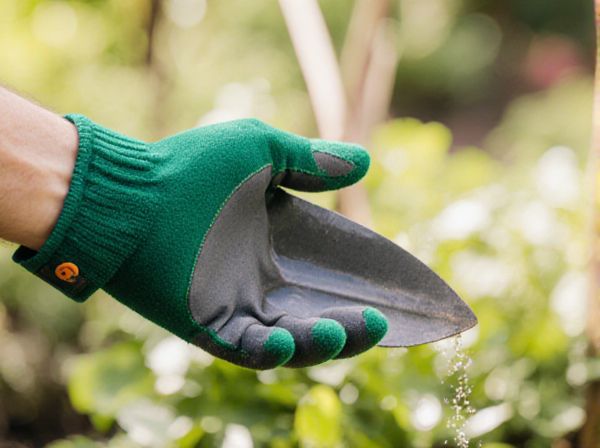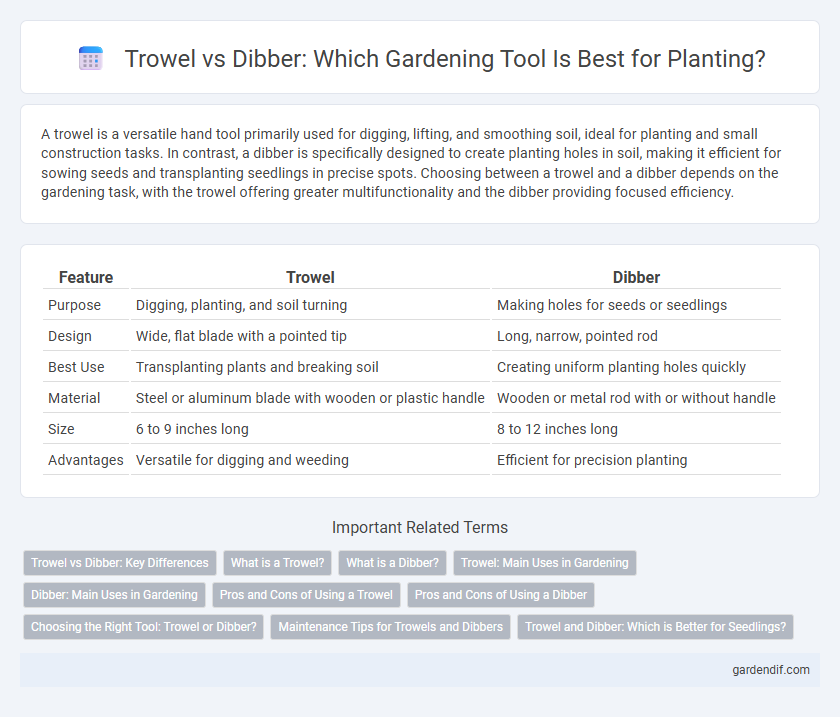
Trowel vs Dibber Illustration
A trowel is a versatile hand tool primarily used for digging, lifting, and smoothing soil, ideal for planting and small construction tasks. In contrast, a dibber is specifically designed to create planting holes in soil, making it efficient for sowing seeds and transplanting seedlings in precise spots. Choosing between a trowel and a dibber depends on the gardening task, with the trowel offering greater multifunctionality and the dibber providing focused efficiency.
Table of Comparison
| Feature | Trowel | Dibber |
|---|---|---|
| Purpose | Digging, planting, and soil turning | Making holes for seeds or seedlings |
| Design | Wide, flat blade with a pointed tip | Long, narrow, pointed rod |
| Best Use | Transplanting plants and breaking soil | Creating uniform planting holes quickly |
| Material | Steel or aluminum blade with wooden or plastic handle | Wooden or metal rod with or without handle |
| Size | 6 to 9 inches long | 8 to 12 inches long |
| Advantages | Versatile for digging and weeding | Efficient for precision planting |
Trowel vs Dibber: Key Differences
Trowels feature a flat, broad blade designed for digging, scooping, and smoothing soil, making them ideal for planting and transplanting tasks. Dibbers consist of a pointed, slender shaft primarily used to create uniform holes for seeds or bulbs in gardening and planting. The key difference lies in the trowel's versatility for soil manipulation versus the dibber's specialization in precise hole creation.
What is a Trowel?
A trowel is a hand tool with a flat, pointed metal blade used for digging, smoothing, and applying materials such as mortar or soil in gardening and masonry. It provides precision for planting bulbs, transplanting seedlings, and detailed masonry work. Unlike a dibber, which creates holes for seeds or plants, a trowel offers versatility in shaping and moving earth or mortar.
What is a Dibber?
A dibber is a pointed gardening tool used to create precise holes in soil for planting seeds, bulbs, or seedlings. It typically features a wooden or metal handle with a tapered, conical tip designed for easy soil penetration and consistent hole depth. Unlike a trowel, which is used for digging and scooping, a dibber ensures accurate planting placement and spacing.
Trowel: Main Uses in Gardening
A trowel is essential for gardening tasks such as digging small holes, transplanting seedlings, and mixing soil or fertilizer. Its pointed, scoop-shaped blade allows for precise control when working with plants and soil in confined spaces. Gardeners rely on trowels for planting bulbs, removing weeds, and aerating soil around delicate root systems.
Dibber: Main Uses in Gardening
A dibber is primarily used for making precise holes in soil to plant seeds, bulbs, and young plants, ensuring uniform depth and spacing. Its narrow, pointed design allows gardeners to efficiently create planting holes without disturbing surrounding soil or roots. This tool is essential for transplanting seedlings and small plants, promoting healthy growth by providing optimal planting conditions.
Pros and Cons of Using a Trowel
A trowel excels in versatility, allowing precise digging, planting, and soil mixing, making it ideal for detailed gardening tasks. Its sturdy metal blade can handle tougher soil and roots but may require more effort and skill to use effectively compared to a dibber. However, the trowel's heavier design can lead to hand fatigue during prolonged use, limiting efficiency for deep hole planting.
Pros and Cons of Using a Dibber
A dibber offers precise control for planting seeds and bulbs, making it ideal for small-scale gardening and ensuring consistent planting depth. Its simple design reduces strain during repetitive planting tasks, but it is less versatile than a trowel, which can dig, scoop, and transplant with ease. However, dibbers are less efficient for moving soil or larger plants, limiting their functionality compared to trowels in diverse gardening activities.
Choosing the Right Tool: Trowel or Dibber?
Choosing the right gardening tool depends on the task: a trowel offers versatility for digging, planting, and loosening soil with its flat, pointed blade, making it ideal for transplanting small plants and mixing soil. A dibber specializes in creating precise planting holes, especially useful for seeds and bulbs, providing consistent depth and spacing. Evaluate soil type, plant size, and project detail to determine whether the broad functionality of a trowel or the focused precision of a dibber best suits your gardening needs.
Maintenance Tips for Trowels and Dibbers
Regularly cleaning trowels and dibbers with warm, soapy water prevents soil buildup and rust formation, extending tool life. Sharpening the edges of trowels with a file and oiling wooden handles of both tools reduces wear and improves functionality. Storing these gardening tools in a dry, ventilated space protects metal parts from moisture damage and preserves wooden components from cracking.
Trowel and Dibber: Which is Better for Seedlings?
A trowel provides precise digging and soil manipulation, ideal for transplanting seedlings with minimal root disturbance. A dibber excels at making uniform holes for planting seeds or seedlings, ensuring consistent depth for optimal growth. Choosing between a trowel and dibber depends on whether the priority is root handling or planting consistency for seedlings.
Trowel vs Dibber Infographic

 gardendif.com
gardendif.com